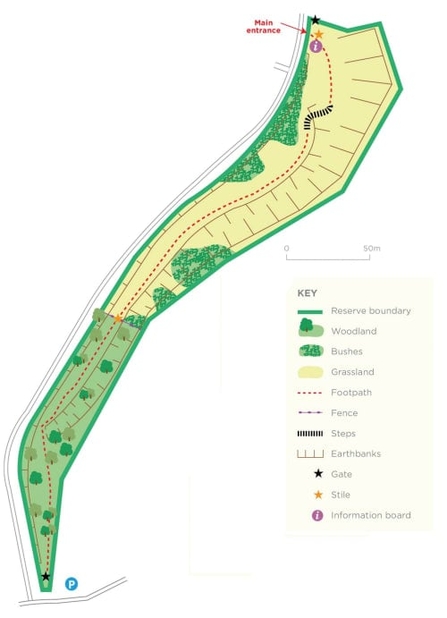Duke of Burgundy butterfly. Credit: Eleanor Dodson.
Location
Know before you go
Dogs
See our FAQ's for more information
When to visit
Opening times
Open at all timesBest time to visit
Spring and summer. Nearby attractions include Highclere Castle (7 miles), Ludgershall Castle (8 miles), Donnington Castle (9 miles), Finkley Down Farm Park (10 miles).About the reserve
Ham Hill is a tiny area of steeply sloping chalk downland strewn with wildflowers and offering great views. A path runs through it and a flight of steps leads to the top of the embankment. The reserve is part of a holloway (sunken track) dating back to Saxon or medieval times on the route from Hungerford to Andover. The banks are a designated Site of Special Scientific Interest for their rich variety of plants and wildlife.
The site is grazed with sheep by a local grazier. This controls the scrub that would otherwise crowd out the wildflowers. Volunteers help clear the scrub and coppice some of the trees.
In spring, cowslips, early purple orchids and violets provide food for the caterpillar of the Duke of Burgundy butterfly.
In July, look for the tiny, yellow-green, powerfully scented musk orchid, a nationally scarce species that is found in very few sites in Wiltshire. You may also find a few burnt orchids. Twayblades, common spotted, fragrant and pyramidal orchids are scattered throughout the reserve. Birds such as chaffinch and yellowhammer nest in the bushes. Listen for the deep croak of roosting ravens. Look out for the rare Roman snail, Britain’s largest. Its spherical shell ranges from white to grey, has pale brown bands and grows up to 5cm across.
Species
Contact us
Environmental designation
Grassland Restoration Update
For public safety, we temporarily needed to close Ham Hill nature reserve until February 2024 to remove ash trees due to the risk of infected trees collapsing or shedding branches onto the road.
Before Wiltshire Wildlife Trust leased the land at Ham Hill, the ash trees had been planted in the eighties as a cash crop. Due to the fact that the rest of the site is a Site of Special Scientific Interest (SSSI), planting trees on chalk grassland is not a management practice that we would condone today.
Lowland calcareous grassland is a species-rich habitat that is becoming increasingly scarce throughout Europe and is ecologically more diverse than secondary ash woodland. Therefore, whilst we would not normally consider the clear-fell of any woodland, the emergence of ash-dieback has created a superb opportunity to revert the site back to its original natural chalk downland habitat. Over time, this will provide an extension and buffer to the extremely rich SSSI grassland to the north.
Since the removal of the infected ash trees, we have begun a programme of chalk grassland restoration. Conservation work will focus on habitat for the rare Duke of Burgundy butterfly, rare wildflowers such as the musk orchid and the Roman snail. Works will include:
- Installation of infrastructure so that our herdwick sheep can be on site for conservation grazing
- Installation of new signage
- Engagement with the local community to communicate our plan
- Opportunity for local people to take part in volunteer activities on the site
- Scrub and debris removal to create short turf and open chalk grassland conditions
- Planting of blackthorn scrub for the brown hairstreak butterfly
- Planting of cowslip and devil's-bit scabious for the Duke of Burgundy and marsh fritillary butterflies
Look out for volunteering opportunities at Ham Hill soon on our volunteering site, including scrub management and planting.
Please visit our Ash Dieback webpage for more information about our wider approach to Ash Dieback at our nature reserves.
If you have any concerns or queries, please do not hesitate to contact us at reserves@wiltshirewildlife.org.
Map of Ham Hill



